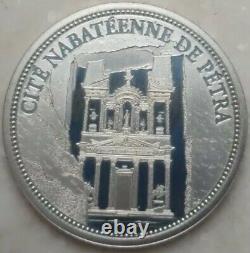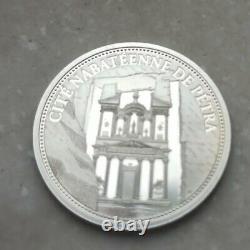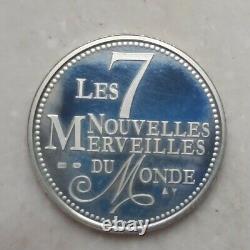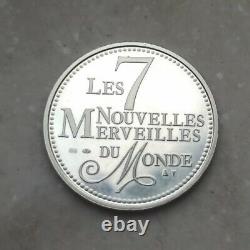
- Index
- Actor
- Director
- Genre
- Action & Adventure (18)
- Action / Adventure (10)
- Adventure (4)
- Animation & Anime (4)
- Documentary (6)
- Fantasy (21)
- Fiction (4)
- History (10)
- Jazz (5)
- Metal (18)
- Mmorpg (13)
- Pop (9)
- Pop / Rock (15)
- Rock (272)
- Rock & Pop (40)
- Role Playing (86)
- Science Fiction (4)
- Sports (9)
- Strategy (5)
- War (4)
- Other (4263)
- Language
- Studio
- Type
- Action Figure (64)
- Album (52)
- Artist Bear (13)
- Banknotes (14)
- Book (14)
- Complete Game (16)
- Complete Set (17)
- Doll (16)
- Fanclub Memorabilia (13)
- Fashion Doll (32)
- Figurine (26)
- Game Board (23)
- Handheld System (50)
- Hardback (20)
- Novel (13)
- Poster (24)
- Print (64)
- Reference (18)
- Textbook (180)
- World Atlas (17)
- Other (4134)
Petra in JORDAN? The NEW 7 WONDERS of the world? SILVER PROOF 9.5gr 30mm






The item on the pictures is the one that you will receive. Look carrefully and judge for your self for the quallity and the grade. Each additional light weight item is free.
From top left to right: the Urn Tombs, en-Nejr theatre, Al-Khazneh. Temple and view of Ad Deir.Possibly as early as the 5th century BC. 1,135,300 (in 2019).
"Rock", originally known to its inhabitants as Raqmu or Raqemo. Is an historic and archaeological city in southern Jordan. It is adjacent to the mountain of Jabal Al-Madbah. Surrounded by mountains forming the eastern flank of the Arabah. Valley running from the Dead Sea.To the Gulf of Aqaba. The area around Petra has been inhabited from as early as 7000 BC. Might have settled in what would become the capital city of their kingdom.
As early as the 4th century BC. Archaeological work has only discovered evidence of Nabataean presence dating back to the second century BC. By which time Petra had become their capital. The Nabataeans were nomadic Arabs. Who invested in Petra's proximity to the incense trade routes.By establishing it as a major regional trading hub. The trading business gained the Nabataeans considerable revenue and Petra became the focus of their wealth. The Nabataeans were accustomed to living in the barren deserts, unlike their enemies, and were able to repel attacks by taking advantage of the area's mountainous terrain. They were particularly skillful in harvesting rainwater.
Petra flourished in the 1st century AD, when its famous Al-Khazneh. Structure - believed to be the mausoleum.
Of Nabataean king Aretas IV. Was constructed, and its population peaked at an estimated 20,000 inhabitants.Although the Nabataean kingdom became a client state of the Roman Empire. In the first century BC, it was only in 106 AD that it lost its independence. Petra fell to the Romans, who annexed Nabataea and renamed it as Arabia Petraea. Petra's importance declined as sea trade routes emerged, and after an earthquake in 363. Several Christian churches were built, but the city continued to decline, and by the early Islamic era it was abandoned except for a handful of nomads.
It remained unknown to the West until it was rediscovered in 1812 by Johann Ludwig Burckhardt. Access to the city is through a 1.2-kilometre-long. Mi gorge called the Siq. Which leads directly to the Khazneh. Famous for its rock-cut architecture.
And water conduit system, Petra is also called the "Red Rose City" because of the colour of the stone from which it is carved. It has been a UNESCO.UNESCO has described Petra as "one of the most precious cultural properties of man's cultural heritage". In 2007, Al-Khazneh was voted one of the New 7 Wonders of the World. Petra is a symbol of Jordan, as well as Jordan's most-visited tourist attraction.
Tourist numbers peaked at 918,000 in 2010, but there followed a temporary slump during the political instability generated by the Arab Spring. Which affected countries surrounding Jordan. Visitor numbers subsequently increased and reached a record-breaking 1.1 million tourists in 2019, marking the first time that the figure rose above the 1 million mark. Tourism in the city was crippled. And other writers identify Petra as the capital of the Nabataean Kingdom.And the centre of their caravan. Enclosed by towering rocks and watered by a perennial stream.
Petra not only possessed the advantages of a fortress, but controlled the main commercial routes which passed through it to Gaza. In the west, to Bosra. In the north, to Aqaba. And Leuce Come on the Red Sea. And across the desert to the Persian Gulf.
Excavations have demonstrated that it was the ability of the Nabataeans to control the water supply that led to the rise of the desert city, creating an artificial oasis. The area is visited by flash floods. But archaeological evidence shows that the Nabataeans controlled these floods by the use of dams. These innovations stored water for prolonged periods of drought.
And enabled the city to prosper from its sale. In ancient times, Petra might have been approached from the south on a track leading across the plain of Petra, around Jabal Haroun ("Aaron's Mountain"), the location of the Tomb of Aaron.
Said to be the burial place of Aaron. Another approach was possibly from the high plateau to the north. Today, most modern visitors approach the site from the east.
The impressive eastern entrance leads steeply down through a dark, narrow gorge, in places only 3-4 m (10-13 ft) wide, called the Siq. ("shaft"), a natural geological feature formed from a deep split in the sandstone. Rocks and serving as a waterway flowing into Wadi Musa. At the end of the narrow gorge, the Siq.Stands Petra's most elaborate ruin, popularly known as Al-Khazneh. ("the Treasury"), hewn into the sandstone cliff. While remaining in remarkably preserved condition, the face of the structure is marked by hundreds of bullet holes made by the local Bedouin tribes that hoped to dislodge riches that were once rumoured to be hidden within it.
A little farther from the Treasury, at the foot of the mountain called en-Nejr, is a massive theatre. Positioned so as to bring the greatest number of tombs. At the point where the valley opens out into the plain, the site of the city is revealed with striking effect. The theatre was cut into the hillside and into several of the tombs during its construction. Rectangular gaps in the seating are still visible.Almost enclosing it on three sides are rose-coloured mountain walls, divided into groups by deep fissures and lined with knobs cut from the rock in the form of towers. The Petra Pool and Garden Complex. Is a series of structures within the city center. Originally said to be a market area.
Excavations at the site have allowed scholars to identify it as an elaborate Nabataean garden, which included a large swimming pool, an island-pavilion, and an intricate hydraulic system. In Petra, there is a semi-arid climate. Most rain falls in the winter. The Köppen-Geiger climate classification is BSk.
The average annual temperature in Petra is 15.5 °C (59.9 °F). About 193 mm (7.60 in) of precipitation falls annually. By 7000 BCE, some of the earliest recorded farmers had settled in Beidha.
Settlement just north of Petra. Petra is listed in Egyptian campaign accounts and the Amarna letters. As Pel, Sela or Seir.
The Edomite site excavated at the top of the Umm el-Biyara mountain at Petra was established not earlier than the seventh century BCE (Iron II). Were one among several nomadic Bedouin tribes that roamed the Arabian Desert. And moved with their herds to wherever they could find pasture and water. Although the Nabataeans were initially embedded in Aramaic culture, theories about them having Aramean. Roots are rejected by many modern scholars. Instead, archaeological, religious and linguistic evidence confirm that they are a northern Arabian tribe. Current evidence suggests that the Nabataean name for Petra was Raqemo, variously spelled in inscriptions as rqmw or rqm.37-100 writes that the region was inhabited by the Midianites. During the time of Moses. And that they were ruled by five kings, one of whom was Rekem. Josephus mentions that the city, called Petra by the Greeks, "ranks highest in the land of the Arabs" and was still called Rekeme by all the Arabs of his time, after its royal founder Antiquities iv.
The Rekem Inscription before it was buried by the bridge abutments. The name'Rekem' (rqm) was inscribed in the rock wall of the Wadi Musa opposite the entrance to the Siq. However, Jordan built a bridge over the wadi and this inscription was buried beneath tons of concrete. See also: Sela (Edom) § Confusion with Petra. An old theory held that Petra might be identified with a place called sela in the Hebrew Bible.
Encyclopædia Britannica (1911) states that the Semitic. Name of the city, if not Sela, would remain unknown. It nevertheless cautioned that sela simply means "rock" in Hebrew, and thence might not be identified with a city where it occurs in the biblical text. The passage in Diodorus Siculus. 94-97 which describes the expeditions which Antigonus.
Sent against the Nabataeans in 312 BCE, was understood by some researchers - and not so by others - to throw some light upon the history of Petra, but the "petra" (Greek for rock) referred to as a natural fortress and place of refuge cannot be a proper name, and the description implies that there was no town in existence there at the time. Roman bronze coin of Geta showing the Petra temple with statue of Tyche. In AD 106, when Cornelius Palma.Under the rule of Petra was absorbed into the Roman Empire. As part of Arabia Petraea.
And Petra became its capital. The native dynasty came to an end but the city continued to flourish under Roman rule. It was around this time that the Petra Roman Road was built.A century later, in the time of Alexander Severus. When the city was at the height of its splendor, the issue of coinage came to an end.
There was no more building of sumptuous tombs, owing apparently to some sudden catastrophe, such as an invasion by the neo- Persian. Power under the Sassanid Empire. 130-270 grew in importance and attracted the Arabian trade away from Petra, the latter declined. It appears, however, to have lingered on as a religious centre. Another Roman road was constructed at the site.
315-403 writes that in his time a feast was held there on December 25 in honour of the virgin Khaabou. (Chaabou) and her offspring Dushara.
Dushara and al-Uzza were two of the main deities of the city, which otherwise included many idols from other Nabataean deities such as Allat and Manat. Between 111 and 114, Trajan. Built the Via Traiana Nova. Running from the Syrian border to the Red Sea through Petra. This road followed the old routes of Nabataean caravans. In the shadow of the Pax Romana. This route revived trade between Arabia, Syria, and Mediterranean harbors. In 125 AD, one of Emperor Hadrian.In Petra, pointed out by documents found at the Dead Sea. In 130 AD, Hadrian visited the former Nabataean capital, giving it the name of Hadriani Petra Metropolis, imprinted on his coins. His visit, however, did not lead to any boom in architectural development and new buildings as it did in Jerash. The province's governor, Sextius Florentinus, erected a monumental mausoleum. For his son near the end of the al-Hubta (King's Wall) tombs, which had been generally reserved during the Nabataean period for the royal family.
The interest that Roman emperors showed for the city in the 3rd century suggests that Petra and its environs remained highly esteemed for a long time. An inscription to Liber Pater. A god revered by Emperor Septimius Severus. Was found in the temenos.
Of the temple known as Qasr al-Bint. And Nabataean tombs contained silver coins with the Emperor's portrait, as well as pottery from his reign. Declared Petra to be a Roman colony. When he reorganised the Roman Empire towards the end of the 3rd century. The area from Petra to Wadi Mujib.
Were annexed into the province of Palaestina Salutaris. Petra may be seen on the Madaba mosaic map. From the reign of Emperor Justinian. Petra declined rapidly under Roman rule, in large part from the revision of sea-based trade routes. Destroyed many buildings and crippled the vital water management system.
The old city of Petra was the capital of the Byzantine province of Palaestina III. And many churches from the Byzantine period.
Were excavated in and around Petra. In one of them, the Byzantine Church. Were discovered, which contained mainly contracts dated from 530s to 590s, establishing that the city was still flourishing in the 6th century. The Byzantine Church is a prime example of monumental architecture in Byzantine Petra. The last reference to Byzantine Petra comes from the Spiritual Meadow.
Written in the first decades of the 7th century. He gives an anecdote about its bishop, Athenogenes. It ceased to be a metropolitan bishopric.
Sometime before 687, when that function had been transferred to Areopolis. Petra is not mentioned in the narratives of the Muslim conquest of the Levant. Nor does it appear in any early Islamic records. In the 12th century, the Crusaders. Built fortresses such as the Alwaeira Castle.But were forced to abandon Petra after a while. As a result, the location of Petra was lost for the Western world until the 19th century.
Two further Crusader-period castles are known in and around Petra: the first is al-Wu'ayra, situated just north of Wadi Musa. It can be viewed from the road to Little Petra.
It is the castle of Valle Moise which was seized by a band of Turks with the help of local Muslims and only recovered by the Crusaders after they began to destroy the olive trees of Wadi Musa. The potential loss of livelihood led the locals to negotiate surrender. The second is on the summit of el-Habis, in the heart of Petra, and can be accessed from the West side of the Qasr al-Bint.The ruins of Petra were an object of curiosity during the Middle Ages. And were visited by Baibars. One of the first Mamluk sultans of Egypt.
Towards the end of the 13th century. View of the Royal Tombs in Petra.
The first European to describe them was Swiss traveller Johann Ludwig Burckhardt. During his travels in 1812. At that time, the Greek Church of Jerusalem.
Operated a diocese in Al Karak. In Greek and it was the opinion among the clergy of Jerusalem that Kerak was the ancient city of Petra.
And Louis-Maurice-Adolphe Linant de Bellefonds. Made the first accurate drawings of Petra in 1828.The Scottish painter David Roberts. The leading American landscape painter of the 19th century, visited Petra in 1868, and the resulting painting El Khasné, Petra. Is among his most important and well-documented.
Missionary Archibald Forder published photographs of Petra in the December 1909 issue of National Geographic. In 1947 (left) compared with the same location in 2013. Because the structures weakened with age, many of the tombs became vulnerable to thieves, and many treasures were stolen. In 1929, a four-person team, consisting of British archaeologists Agnes Conway. Palestinian physician and folklore expert Dr Tawfiq Canaan.
And Dr Ditlef Nielsen, a Danish scholar, excavated and surveyed Petra. The archaeologist Philip Hammond from the University of Utah. Visited Petra for nearly 40 years. He explained that the local folklore says it was created by the wand of Moses. When he struck the rock to bring forth water for the Israelites.
Hammond believed the carved channels deep within the walls and ground were made from ceramic pipes that once fed water for the city, from rock-cut systems on the canyon rim. Numerous scrolls in Greek and dating to the Byzantine. Period were discovered in an excavated church near the Temple of the Winged Lions. In Petra in December 1993. The Nabataeans worshipped Arab gods.
Era as well as a few of their deified. Was deified after his death. Was the primary male god accompanied by his three female deities: Al-'Uzza.
Many statues carved in the rock depict these gods and goddesses. New evidence indicates that broader Edomite. And Nabataean theology had strong links to Earth-Sun relationships, often manifested in the orientation of prominent Petra structures to equinox and solstice sunrises and sunsets. Dedicated to Qos-Allah'Qos is Allah' or'Qos the god', by Qosmilk (melech - king) is found at Petra (Glueck 516). Qos is identifiable with Kaush (Qaush) the God of the older Edomites. The stele is horned and the seal from the Edomite Tawilan near Petra identified with Kaush displays a star and crescent. (Browning 28), both consistent with a moon deity. It is conceivable that the latter could have resulted from trade with Harran. There is continuing debate about the nature of Qos (qaus - bow) who has been identified both with a hunting bow (hunting god) and a rainbow (weather god) although the crescent above the stele is also a bow.Nabataean inscriptions in Sinai and other places display widespread references to names including Allah, El and Allat (god and goddess), with regional references to al-Uzza, Baal. And Manutu (Manat) (Negev 11).
Allat is also found in Sinai in South Arabian language. Allah occurs particularly as Garm-'allahi - god decided (Greek Garamelos) and Aush-allahi - "gods covenant" (Greek Ausallos). We find both Shalm-lahi "Allah is peace" and Shalm-allat, "the peace of the goddess". We also find Amat-allahi "she-servant of god" and Halaf-llahi "the successor of Allah". Petra's largest monument, dates from the 1st century BC. It was dedicated to Obodas I and is believed to be the symposium of Obodas the god. This information is inscribed on the ruins of the Monastery the name is the translation of the Arabic Ad Deir. The Temple of the Winged Lions. Is a large temple complex dated to the reign of King Aretas IV. The temple is located in Petra's so-called Sacred Quarter, an area situated at the end of Petra's main Colonnaded Street consisting of two majestic temples, the Qasr al-Bint. And, opposite, the Temple of the Winged Lions on the northern bank of Wadi Musa. Found its way to Petra in the 4th century AD, nearly 500 years after the establishment of Petra as a trade centre. Mentions a bishop of Petra Anhioch.At least one of the tombs the "tomb with the urn"? Was used as a church.
An inscription in red paint records its consecration "in the time of the most holy bishop Jason" (447). Conquest of 629-632, Christianity in Petra, as of most of Arabia, gave way to Islam. Petra was occupied by Baldwin I. Of the Kingdom of Jerusalem. And formed the second fief.In the lordship of Oultrejordain. With the title Château de la Valée de Moyse or Sela. It remained in the hands of the Franks.
It is still a titular see. According to Arab tradition, Petra is the spot where Musa. Struck a rock with his staff and water came forth, and where Moses' brother, Harun. Known today as Jabal Haroun or Mount Aaron.
The Wadi Musa or "Wadi of Moses" is the Arab name for the narrow valley at the head of which Petra is sited. A mountaintop shrine of Moses' sister Miriam. Was still shown to pilgrims at the time of Jerome. In the 4th century, but its location has not been identified since. UNESCO listing of ancient Petra and Bedouin heritage.
See also: List of World Heritage Sites in Jordan. The most popular tourist attraction. The site suffers from a host of threats, including collapse of ancient structures, erosion from flooding and improper rainwater drainage, weathering from salt upwelling. Improper restoration of ancient structures and unsustainable tourism. The last has increased substantially, especially since the site received widespread media coverage in 2007 during the New7Wonders of the World. In an attempt to reduce the impact of these threats, the Petra National Trust. (PNT) was established in 1989. It has worked with numerous local and international organisations on projects that promote the protection, conservation, and preservation of the Petra site. Moreover, UNESCO and ICOMOS recently collaborated to publish their first book on human and natural threats to the sensitive World Heritage sites.They chose Petra as its first and the most important example of threatened landscapes. The presentation Tourism and Archaeological Heritage Management at Petra: Driver to Development or Destruction? (2012) was the first in a series to address the very nature of these deteriorating buildings, cities, sites, and regions. Tombs in the southern part of the city.

